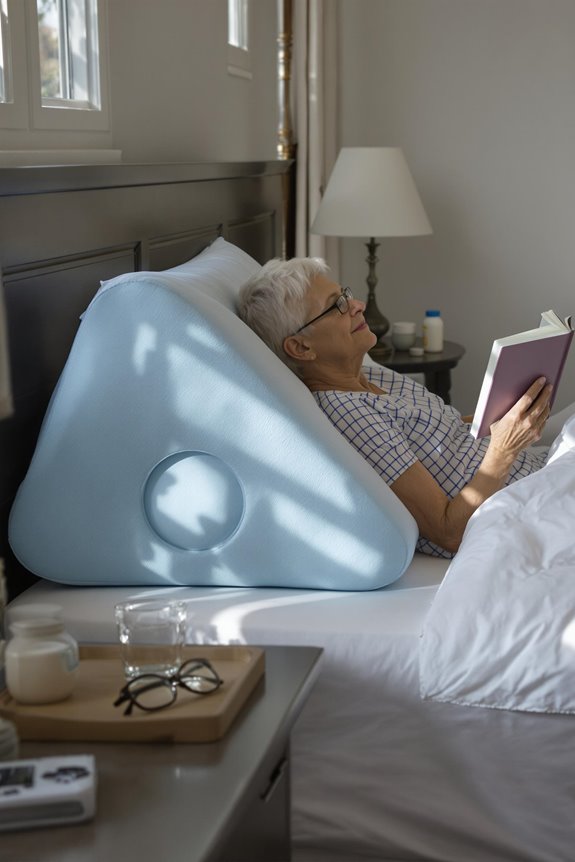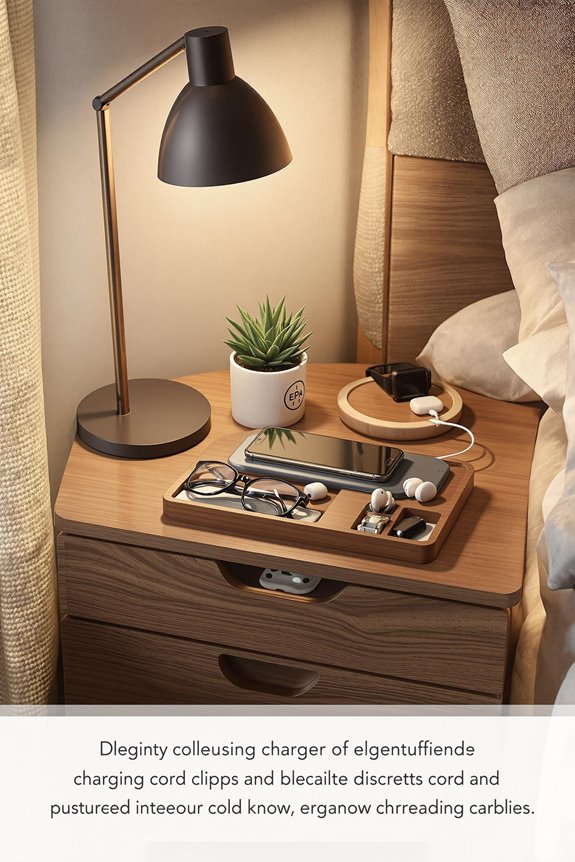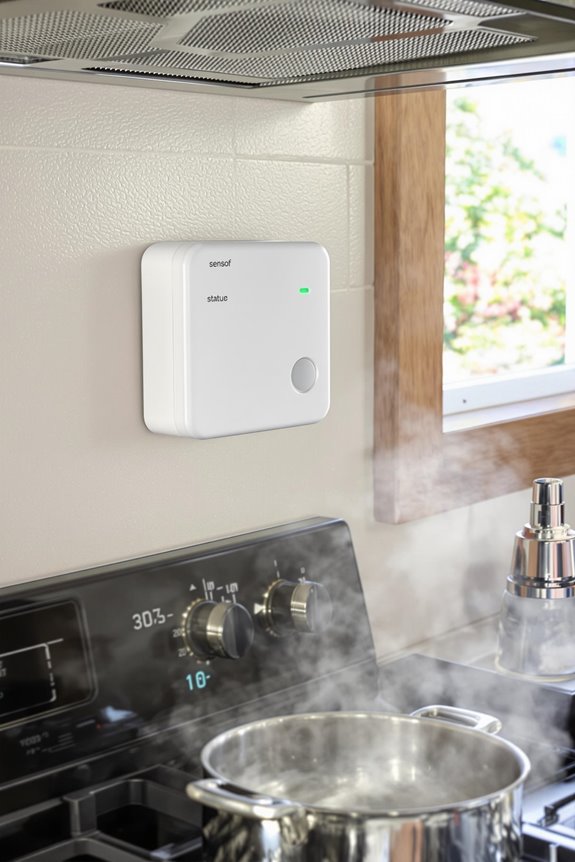As you age, maintaining your independence in the bathroom becomes increasingly important. Long handle bath brushes and sponges offer a practical solution for reaching difficult areas without straining or requiring assistance. You’ll find these simple tools can transform your shower experience, providing both physical comfort and emotional dignity. The right bath extension tool can make the difference between needing help and maintaining your privacy—a small investment with significant impact on your daily routine.
Key Takeaways
- Long-handled bath brushes extend reach by 15-24 inches, enabling seniors to clean hard-to-reach areas without assistance.
- Ergonomic, non-slip handles provide secure grip in wet conditions, essential for users with arthritis or limited dexterity.
- Lightweight designs under 8 ounces reduce arm fatigue during use, making bathing more comfortable for those with mobility issues.
- Regular maintenance by rinsing after use and hanging in ventilated areas prevents mildew growth and extends product lifespan.
- Mid-range options ($16-$25) offer the best balance of durability, ergonomic features, and value for independent showering.
Long Handle Bath Brushes and Sponges

Bathing independence often hinges on the right tools for our senior loved ones. Long handle bath brushes and sponges provide essential accessibility for those with limited mobility, allowing seniors to maintain dignity while aging in place.
When choosing these tools, prioritize ergonomic grips and lightweight designs for comfort. Look for brushes with soft bristles to protect sensitive skin, while ensuring handles extend at least 15-20 inches for maximum reach. Some models feature bendable handles for hard-to-reach areas.
Consider installation and placement carefully—store tools within easy reach but away from areas where they might cause tripping. Prices typically range from $10-$30, with more durable options at the higher end.
For fall prevention, pair these tools with non-slip mats and grab bars for thorough bathroom safety.
What it is and the daily problems it solves
Long handle bath brushes and sponges address a common yet often overlooked challenge many seniors face daily: the inability to reach various parts of their body during bathing.
These simple tools extend a person’s reach by 12-24 inches, allowing them to wash their back, legs, and feet without excessive bending or stretching.
For seniors with limited mobility, arthritis, or balance issues, these devices transform a frustrating and potentially dangerous bathing experience into one of independence and dignity.
They eliminate the need to twist awkwardly or risk falling while trying to clean hard-to-reach areas.
Many models feature ergonomic handles with non-slip grips and adjustable heads that can be positioned at various angles, accommodating different needs and preferences.
This preservation of self-care ability is vital for maintaining confidence and autonomy in daily living.
Who benefits and when to use it
While nearly everyone can appreciate the convenience of extended reach tools, seniors with certain physical limitations will find long handle bath brushes and sponges particularly life-changing.
These devices are ideal for those with limited mobility, arthritis, recent surgery recovery, balance issues, or restricted range of motion.
You’ll find these tools most beneficial during daily showers or baths, especially when washing hard-to-reach areas like the back, feet, and lower legs becomes challenging.
They’re perfect for times when bending or twisting might cause pain or risk a fall.
For caregivers, these tools can help maintain your loved one’s dignity by allowing them to handle personal hygiene independently wherever possible, while you provide assistance only when absolutely necessary. Additionally, integrating smart home technology can further enhance safety and autonomy during bathing routines.
Key features to look for
When shopping for a long-handle bath brush or sponge, you’ll want to evaluate several key features that can make bathing safer and more comfortable for your parents.
Not all products are created equal, and the right features can make a significant difference in both usability and durability.
Let’s look at what makes a quality bathing aid worth the investment.
Feature checklist
Shopping for your parents can feel overwhelming with so many bath brush options available. To simplify your decision, I’ve developed this quick feature checklist based on my experience helping seniors maintain their bathing independence in Bergen County homes.
When evaluating long-handled bath brushes and sponges, look for:
- Ergonomic grip with non-slip, textured handle even when wet
- Adjustable or ideal length (18-24 inches works well for most seniors)
- Lightweight design (under 8 ounces) to prevent arm fatigue
- Easy-to-replace brush/sponge heads for hygiene and cost efficiency
- Hanging loop or suction cup for proper drying and storage
Remember that the right bath tool combines comfort, usability, and practical design—all essential for maintaining your parents’ dignity and independence during their daily routines.
How to choose the right long handle bath brushes and sponges
Finding the perfect long-handled bath tools can dramatically improve your parent’s bathing independence. When selecting these tools, consider the handle length—ideally 15-20 inches for most seniors.
Look for ergonomic grips with non-slip surfaces that remain secure even when wet.
The brush or sponge head matters considerably. Soft materials prevent skin irritation, while slightly firmer options may be preferred for effective cleaning.
Some designs feature adjustable heads that can be positioned at various angles, making it easier to reach difficult areas without straining.
Weight is another essential factor. Lightweight materials prevent arm fatigue during use, especially important for those with arthritis or limited upper body strength.
Finally, confirm the connection between handle and head is secure to prevent accidents during bathing.
Placement or installation basics
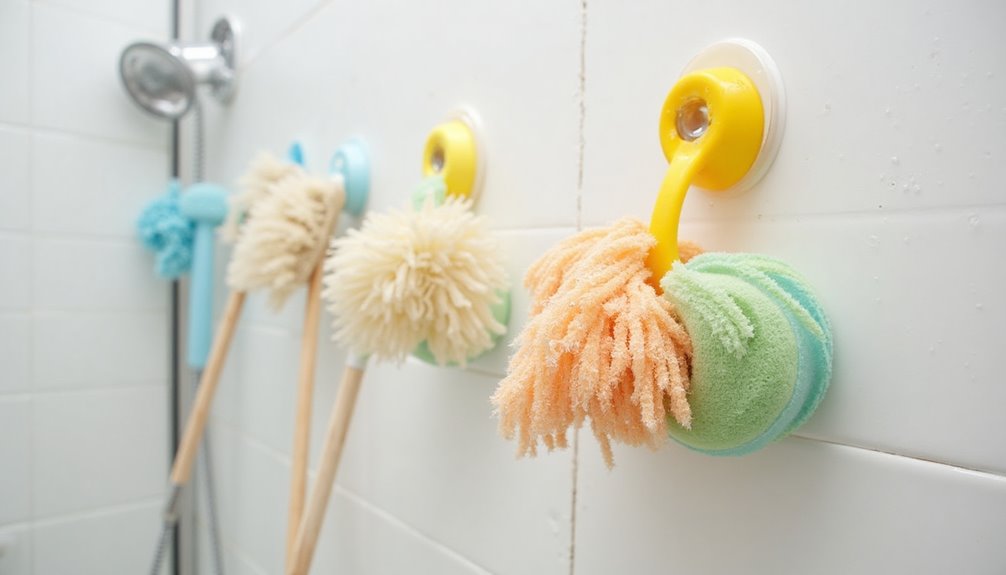
Once you’ve chosen the right long-handled bath tools, proper placement in the bathroom creates an environment that supports independence and safety.
Store these tools within easy reach but out of the way to prevent trips or falls.
Consider installing a hook or holder on the shower wall about 48-52 inches from the floor—high enough to keep the tool from touching the floor but low enough to reach comfortably.
Many long-handled bath tools come with suction cups or hanging loops.
The best locations include:
- Side wall within arm’s reach
- Non-entry wall to avoid door interference
- Away from the water stream to prevent slipping when grabbing
For tools without built-in hangers, consider adding a command hook or shower caddy that won’t require drilling into tiles.
Setup steps
When you’re ready to set up your parent’s long-handled bath tools, following a few simple steps will guarantee they’re properly installed for maximum safety and convenience.
Start by checking that the handle extension is securely attached to the brush or sponge head. Many models require a simple twist-lock mechanism that should click into place.
Next, store the tool within easy reach—consider a shower caddy or suction hook mounted at elbow height, not too high or low.
For tools with replaceable heads, show your parent how to change them safely while seated. Demonstrate proper technique: using the tool with minimal pressure and letting the length work for them rather than stretching.
Remember to periodically check for wear, especially where the handle meets the head, as this connection can weaken over time.
Costs and warranties
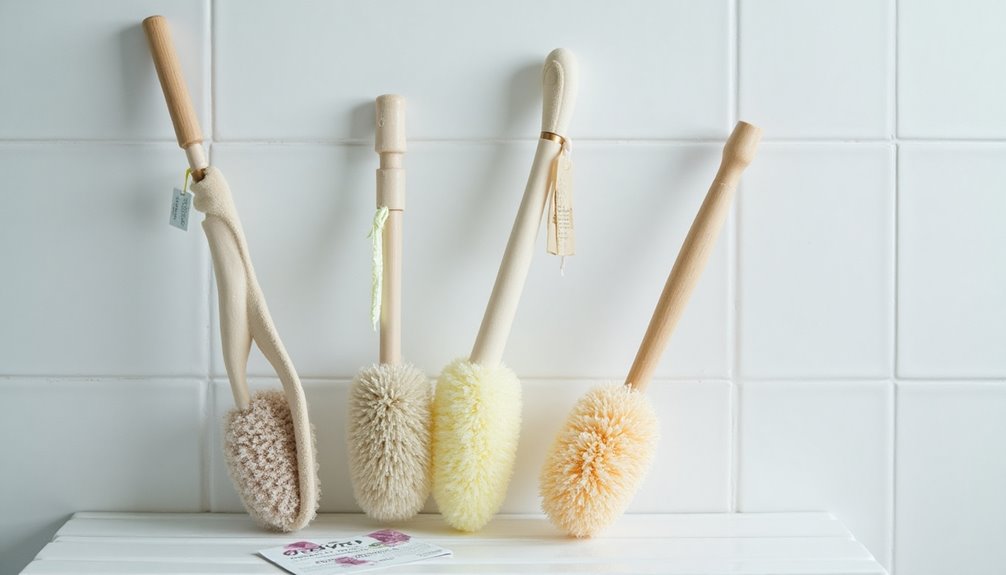
When planning your budget for long handle bath brushes and sponges, you’ll typically find options ranging from $15 for basic models to $45 for premium designs with ergonomic features.
The mid-range options around $25-30 often provide the best balance of durability and functionality for most seniors.
Many quality brands offer 1-2 year warranties, which can provide peace of mind when investing in your loved one’s bathing independence.
Example budget
Three key price points exist in the long-handled bath brush market, letting you find options that fit nearly any budget. Consider these common categories when planning your purchase:
| Budget Level | Price Range | What to Expect |
|---|---|---|
| Economy | $10-$15 | Basic plastic handle, simple brush/sponge head, minimal features |
| Mid-Range | $16-$25 | Ergonomic grip, better materials, replaceable heads |
| Premium | $26-$40 | Antimicrobial materials, cushioned grip, dual-sided heads, extension options |
Most families find the mid-range options offer the best balance of durability and features. Premium models make sense if you need specific therapeutic benefits or enhanced comfort. Remember to factor in replacement heads ($5-$10 each), which you’ll need every 3-6 months for ideal hygiene and effectiveness.
Daily use and upkeep
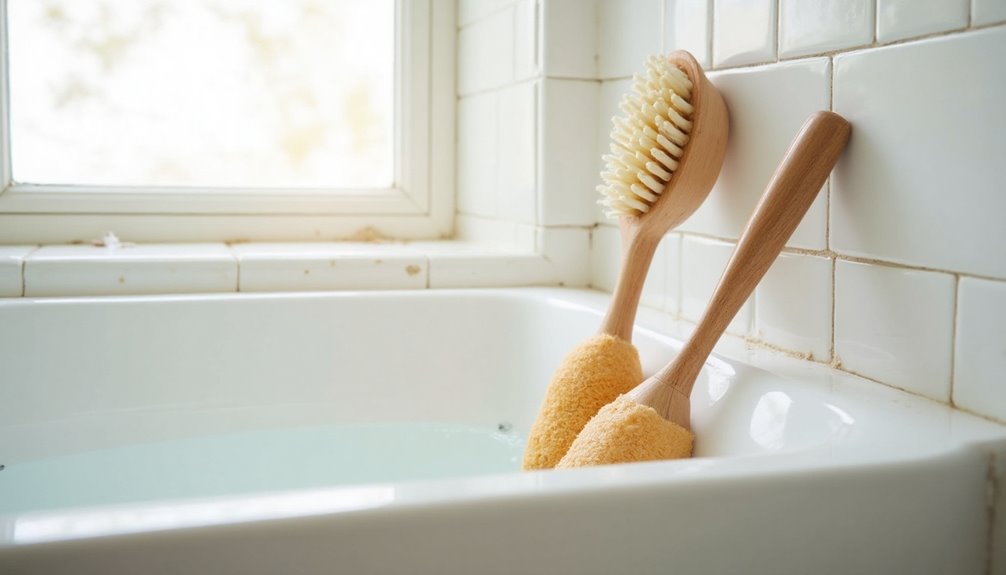
Maintaining bath brushes and sponges properly won’t just extend their lifespan—it’ll also protect your loved one from potential infections.
Clean bath tools aren’t just economical—they’re essential protection against skin infections for aging loved ones.
After each use, encourage your parent to rinse their bath aid thoroughly under running water to remove soap residue and skin cells.
Hang brushes and sponges in a well-ventilated area, not in the damp shower enclosure, to prevent mildew growth.
Once weekly, soak plastic-handled brushes in a solution of warm water and white vinegar (1:1 ratio) for 30 minutes, then rinse and dry.
Replace bath aids every 4-6 weeks, depending on usage frequency and visible wear.
Watch for signs like persistent odors, discoloration, or bristle damage—these indicate it’s time for a replacement.
Remember that proper care of these tools directly impacts your parent’s skin health and hygiene.
Safety tips and mistakes to avoid
Safety serves as the foundation of any bath aid selection for your aging parent. When choosing long-handle bath brushes or sponges, avoid products with rough edges that could scratch sensitive skin.
Check that handles are securely attached to prevent separation during use, which could lead to falls. Never use these tools to support body weight, as they’re not designed as grab bars.
Regularly inspect for mold growth, especially in humid bathrooms where bacteria thrive. Consider non-slip grips for wet hands, and avoid excessively long handles that might become unwieldy in smaller shower spaces.
Remember to replace brushes every three months to prevent bacterial buildup. Store tools hanging or upright to allow proper drying – horizontal storage creates moisture pockets where mold can develop quickly, potentially causing skin irritations or infections.
While long-handle bath brushes serve many seniors well, they aren’t the right solution for everyone.
If your parent has significant mobility limitations or balance issues, consider alternatives like handheld shower sprayers, shower chairs with built-in washing aids, or bath mitts with elastic straps.
These tools aren’t recommended for seniors with severe arthritis in their hands or those who can’t maintain a secure grip. In these cases, consider hiring a professional caregiver for bathing assistance.
Safety first: For seniors with severe hand arthritis or grip issues, professional bathing assistance is the better option.
For seniors with skin sensitivities or conditions like psoriasis, the bristles may be too harsh.
Opt instead for ultra-soft sponges or washcloths attached to shorter, lightweight handles that won’t cause irritation but still provide some reach extension without requiring the same range of motion.
FAQs
Questions about long-handle bath brushes come up frequently when I’m helping families find solutions for their aging parents. Here are answers to the most common ones:
How long should the handle be?
Look for 15-20 inches, depending on mobility limitations.
Are brushes better than sponges?
Brushes offer better scrubbing but sponges are gentler on sensitive skin.
How often should they be replaced?
Every 3-4 months to prevent bacterial growth.
Can they be used with any soap?
Yes, but liquid soap works better than bar soap for most models.
Are they covered by Medicare?
Unfortunately not, but they’re relatively inexpensive compared to other assistive devices.
Do they require installation?
No, they’re ready to use out of the package.
Frequently Asked Questions
Can Seniors With Arthritis Easily Grip and Use Long Handle Bath Brushes?
Yes, seniors with arthritis can use long handle bath brushes, though look for designs with cushioned, ergonomic handles that require less grip strength.
Many models feature non-slip silicone grips or wrist straps for better control. Choose lightweight options with adjustable handles, which minimize strain on painful joints.
Before purchasing, consider the handle thickness and button placement to guarantee they’re easily manipulated despite joint stiffness or limited dexterity.
How Often Should I Replace a Long Handle Bath Sponge?
Replace your bath sponge every 4-6 weeks for hygiene. Moist environments breed bacteria, and you’ll notice when it’s time—discoloration, lingering odors, or deteriorating texture are clear signs.
For seniors with limited dexterity, I recommend setting calendar reminders or subscribing to replacement services.
Don’t wait until it’s falling apart; a fresh sponge provides better cleansing and reduces infection risk, especially important for older adults with sensitive skin.
Are There Waterproof Extensions Available for Existing Bath Brushes?
Yes, waterproof extensions are available for many existing bath brushes.
Look for universal adapters that fit standard-sized handles or brand-specific extensions from manufacturers like Aquasentials or OXO. These extensions typically add 10-18 inches of reach and attach with secure twist-lock mechanisms.
When purchasing, check compatibility with your current brush and guarantee the connection is watertight.
For seniors with limited mobility, these extensions can greatly enhance shower independence without requiring a completely new bathing tool.
Can These Brushes Be Used With All Types of Bath Products?
Most long-handle bath brushes work well with standard liquid soaps, shower gels, and body washes.
However, avoid thick creams or oil-based products as they can clog bristles and create buildup.
For silicone brushes, any product is generally fine.
Mesh sponge attachments hold more lather but require thorough rinsing.
Always check manufacturer guidelines, as some specialized brushes have specific recommendations for maintaining the brush material’s integrity over time.
Do Long Handle Bath Brushes Work Well in Small Shower Stalls?
Yes, long handle brushes work well in small shower stalls if you choose the right size.
Look for models with shorter handles (12-18 inches) and smaller heads designed for compact spaces. Many feature hooks for hanging vertically to save space.
The maneuverability actually helps in tight areas where bending or stretching might be difficult for seniors, allowing them to reach all areas while maintaining balance.
Bottom Line
You’ve discovered how long-handled bath brushes and sponges can transform your showering experience, offering independence when you need it most. By selecting the right tool with proper features, maintaining it correctly, and using it safely, you’ll enjoy greater autonomy during personal care routines. Remember, these simple devices aren’t just bath accessories—they’re powerful tools that help preserve your dignity and self-sufficiency as you age.

